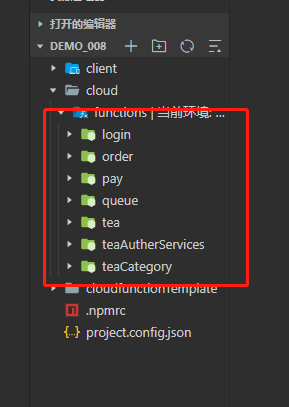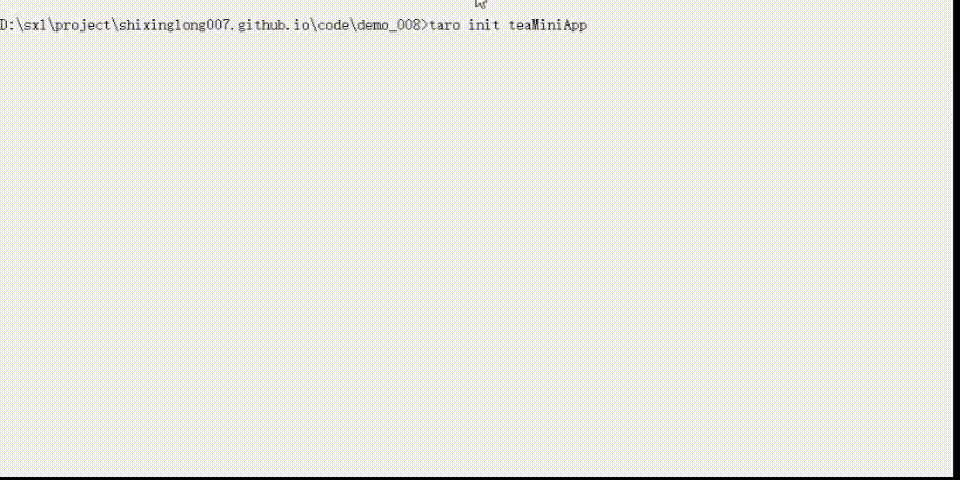2020-5-9
文章编号:009/100
以前很少写文章。从今天开始我要挑战一下自己,连续输出100篇技术类文章。这100篇文章我尽量以实战案例为主。
如果你觉得本文还不错,记得关注或者给个 star,你们的赞和 star 是我编写更多更精彩文章的动力!
GitHub 地址
私人公众号:程序员小石
这里有大量的学习资料,免费分享给你
正文
上一篇文章简单分析了“奶茶店·小程序”,现在我们先来实现接口和数据库。
- 第一篇:业务逻辑拆分,敲定设计稿,设计 API 和数据库
- 第二篇:完成接口开发,测试接口
- 第三篇:完成前端页面,联调接口
本文重点内容
- Taro 构建小程序
- 云函数设计
- 云函数 + 云数据库实现:队列推送
云函数

Taro 构建小程序
windows 系统要安装 python,Nodejs版本要 >=8.0.0
尽量使用Taro 最新版,微信更新的很快。Taro 也会及时跟进
我目前的Taro 版本是 v2.2.3
构建项目

云函数设计
一般一个云函数负责一个模块,比如 Tea, 只负责 Tea 的 CURD 操作。
我的云函数需要两个字段 action 和 params。
其中 action 标记动作,params 是参数。这样设计云函数能提高可扩展性。
// 云函数入口文件
const cloud = require('wx-server-sdk')
const method = require('./method');
cloud.init({ env: 'xxx'})
const db = cloud.database();
exports.db = db
// 云函数入口函数
exports.main = async (event, context) => {
// 接受两个参数
const { action, params } = event
let res = {}
switch(action) {
case 'create': // 增
res = await method.create(params);
break;
case 'del':// 删
res = await method.del(params);
break;
case 'update':// 改
res = await method.update(params);
break;
case 'select':// 查
res = await method.select(params);
break;
}
return res
}
前端代码
// 新增
let res = await Taro.cloud.callFunction({
name: 'tea',
data: {
action: 'create',
params: {
name: '红茶玛奇朵',
price: '18.00',
description: '红茶与奶油的美妙结合....',
imgs: [...],
selects: [...]
}
}
})
// 删除
let res = await Taro.cloud.callFunction({
name: 'tea',
data: {
action: 'del',
params: {
'_id': 'xxx'
}
}
})
这样实现代码可读性强,容易扩展。
其他的云函数我就不一一列举了,大部分都是增删改查的操作。 代码传送门
云函数 + 云数据库实现:队列推送
排队功能是刚需,必须要求实时更新。云开发实现实时排队功能需要三方配合
- 数据库
- 云函数
- 前端监听(调用数据库的 .watch 功能)
数据库设计
把整个队伍整理到一条数据中,每次执行修改操作。这样会降低复杂度
// collection:Queue
// 表结构,描述某一天的排队情况
{
_id: "",
createDate: "2020-5-10", // 以天为key
list: [
{ // 每一个排队的人
beforeIndex: 0,
createTime: Sun May 10 2020 15:04:29 GMT+0800 (中国标准时间),
user,
order,
...
},
{
beforeIndex: 1,
createTime: Sun May 10 2020 15:04:29 GMT+0800 (中国标准时间)
user,
order,
...
},
{
beforeIndex: 2,
createTime: Sun May 10 2020 15:04:29 GMT+0800 (中国标准时间)
user,
order,
...
},
]
}
云函数设计
队列分为两个动作,入队 enqueue,出队 dequeue。
入队时要区分当天是否有队列,没有队列则新增一条数据。有则修改此条数据
入队过程:
锁队列 -> 查询今天的队列,如果没有则初始化队列 -> 入队 -> 同步到数据库 -> 解锁队列
出队过程:
锁队列 -> 查到队列 -> 出队 -> 同步到数据库 -> 解锁队列
由于nodejs是单线程的,我们可以在函数的外部实现一个简单的队列锁
// 队列锁
const queueLock = () => {
let lock = true
return {
get: () => lock,
set: (v) => {
lock = v ? true : false
}
}
}
const lockFn = queueLock()
lockFn.get() // 队列状态
lockFn.set(false) // 锁定队列
lockFn.set(true) // 解锁队列
// enqueue 入队操作
const enqueue = async (params) => {
let res = {
success: true,
errorCode: '-1',
msg: '',
data: null
}
try {
while(1) {
if (lockFn.get() === true) {
// 1. 入队时, 加锁队列
lockFn.set(false)
let queue = null
let date = moment().format('YYYY-M-D')
let res = await main.db.collection(collName).where({ currentDate: date }) .get()
if (res.data.length === 0) {
// 新增队列
queue = QueueFn(date)
} else {
// 入队
queue = res.data[0];
}
params.beforeIndex = queue.list.length; // 等位人数
params.createTime = new Date();
queue.list.push(params);
if (queue._id) {
let newQueue = { ...queue }
delete newQueue['_id'];
await main.db.collection(collName)
.doc(queue._id)
.set({ data: { ...newQueue } })
} else {
await main.db.collection(collName).add({ data: queue })
}
lockFn.set(true);
break;
}
// 轮询减速
await sleep(150)
}
} catch (error) {
res.msg = error
res.errorCode = '1010'
res.msg = error
lockFn.set(true)
}
return res
}
// dequeue 出队操作
const dequeue = async (params) => {
let res = {
success: true,
errorCode: '-1',
msg: '',
data: null
}
try {
while(1) {
if (lockFn.get() === true) {
// 锁队列
lockFn.set(false)
let queue = {}
// 出队
let date = moment().format('YYYY-M-D')
let res = await main.db.collection(collName).where({ currentDate: date }) .get()
if (res.data.length > 0) {
queue = res.data[0]
queue.list.shift()
// 重置 beforeIndex
queue.list = queue.list.map((item, i) => {
item.beforeIndex = i
return item
})
}
let newQueue = {...queue}
delete newQueue['_id']
await main.db.collection(collName)
.doc(queue._id)
.set({ data: { ...newQueue } })
lockFn.set(true)
break;
}
}
} catch (error) {
res.msg = error
res.errorCode = '1010'
res.msg = error
}
return res
}
小程序端代码
const db = wx.cloud.database()
// 队列监听
watcher = db.collection('Queue')
.orderBy('currentDate', 'asc')
.where({
currentDate: moment().format('YYYY-M-D')
})
.limit(1)
.watch({
onChange: function(snapshot) {
console.log('完整队列', snapshot.docs)
},
onError: function(err) {
console.error('the watch closed because of error', err)
}
})
最后
- 想加入我的前端小群的同学,我微信:guzhan321,备注 群
- 喜欢这篇文章的话,请把他分享给有帮助的人
- 有写错的或者你不认同的地方,请通过微信告诉我,谢谢
下一篇文章:完成前端页面,联调接口
